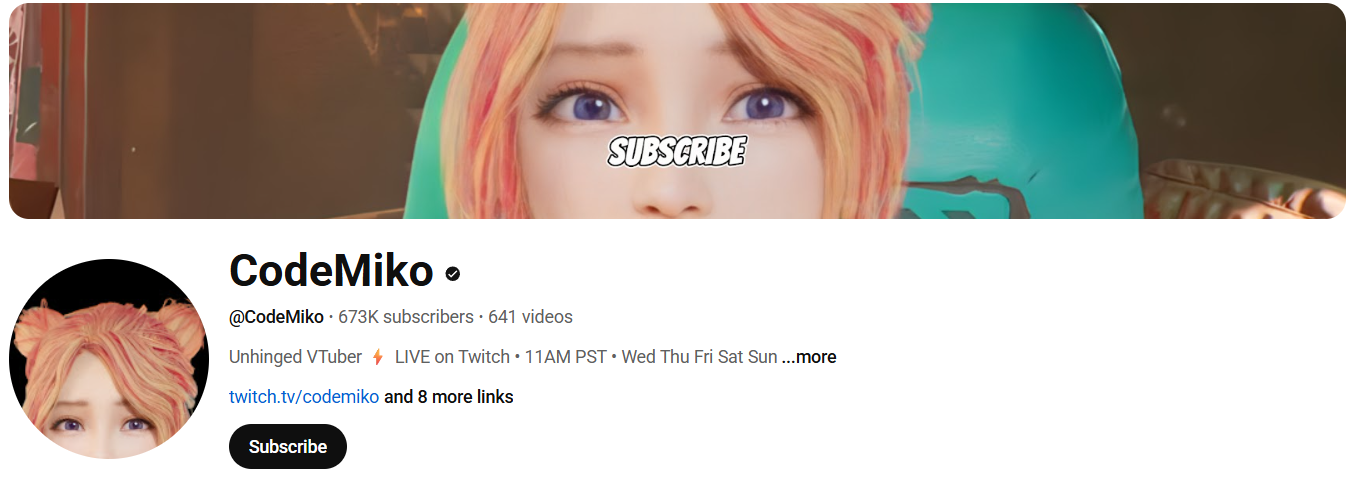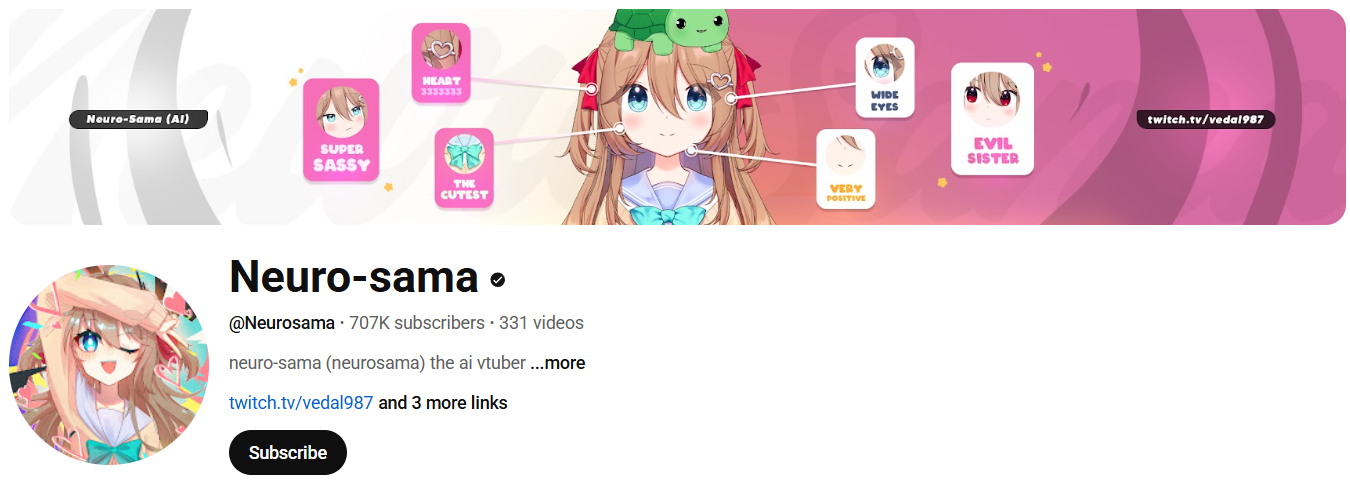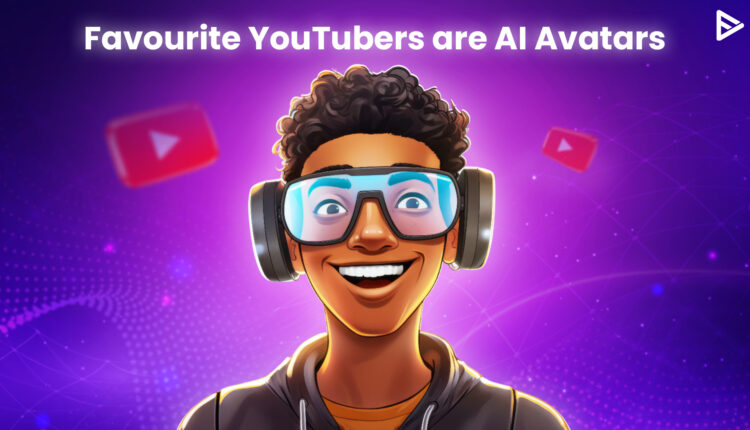Are you a YouTuber who can quickly adapt to changes on the platform? Well, if you are, then you must be aware of the rise of AI Avatars on YouTube. The audience’s viewing preferences and platform trends are evolving. The influence extends beyond AI video creation; the audience has also begun to sympathize with virtually AI-generated personas. The virtual creators are not just gaining subscribers; instead, they are assembling a cult audience base.
The Avatars are a result of AI-generated video creation, which has proven promising enough to capture viewers’ attention and become YouTube celebrities. In this article, we will discuss what YouTube AI Avatars are, decode some popular ones, understand how to create YouTube videos with AI, and explore the trend shift on the YouTube Platform.
YouTube AI Avatars
Let’s examine some popular influencers who utilize virtual AI video creation. VTubers have gained popularity as influencers. The first one is:
Code Miko

Our first VTuber is CodeMiko. Youna Kang created the virtual influencer. Code Miko channel presents content & streams on Twitch and YouTube. The Unreal Engine powered the 3D avatar. The Vtuber does tech-driven conversation on the channel and interacts with other creators using a 4th wall format.
The VTubers have also won an award for “Best VTubers for Streamy Awards”. The trivia behind her creation is that she was a game character who never made it into the final version of the game; therefore, Code Miko is her version that came into existence through the YouTube AI video channel.
Bloo

Jordi Van Den Bussche created the AI Avatar Bloo. The Vtuber creates content on the BlooGaming channel. The channel has 2.58 million subscribers. The channel is famous for its wild character transformations, such as Sonic to Sonic Gold or $1 to $1,000,000 upgrades.
The content mainly revolves around the GTA roleplay. This attracts the existing fan base of other games. One of the famous quotes that popularised the creator and VTuber is “I have always been in love with Lady Shark, but she only dates strong animals.”
The transformation quest begins with creating one of the popular content pieces on the channel.
Neuro Sama

Vedal, an independent programmer, created Vtuber Neuro Sama. The Vtuber started a Twitch stream in 2022 and often creates content with her evil twin sister on YouTube. She is also an AI Avatar.
The AI Avatar is different from other VTubers. Neuro Sama’s voice, gameplay, and movements are all generated by AI systems. Unlike other avatars, which involve human factors, Neuro Sama is completely backed by AI systems.
How To Do AI Video Creation of YouTube Avatars
If you are a creator looking to create an AI Avatar or launch a VTuber, then you need to understand the technical aspects behind the creation. For the context, I’ll categorize this into two segments. The first is where humans are involved, such as Code Miko, and the second is VTubers who are entirely controlled by AI systems, for example, Neuro Sama.
The first step for both models is to create a character and design for a YouTube AI video.
How to Make an AI Avatar Design For YouTube
You have to treat the character just as a human creator. You can’t make drastic changes once it’s in front of people. Start by conceptualizing the entire story for the avatar. From backstory to personality, jot it down. This will help you give style, personality, and appearance to your avatar.
These factors enable the audience to resonate with the characters, which is why I repeatedly emphasize treating the Vtuber as a person. If the avatar has a goal, or the YouTube channel’s content is driven by that goal, then AI video creation and success on YouTube become more rapid.
If you have an animation channel, here are YouTube actionable tips to help grow your channel.
To create a character, various tools are available, including Lived2D, VTube Studio, and Blender.
The Human Driven VTubers (CodeMiko Model)
Since the avatar represents a correlation between a human and an AI, the system requires strong hardware and precise modeling. First, let’s talk about hardware requirements.
Hardware
A creator needs a motion capture suit to capture real-time body movements; this data is used to animate the avatar’s body movements. Sensors like Xsesns MVN suit are used to do this.
To capture facial movements, you can use a facial suit with a camera, or you can use an iPhone with a TrueDepth camera. The phone does the work, so most creators use the phone only, unless you are at the height of professionalism and want a professional setup.
For finer movements such as finger or hand gestures, you can use a specialized suit or gloves like Mansus VR.
To render all the data, you need a high-end PC with a powerful CPU and GPU to process avatars in real-time.
Software
For all the operations, you need an engine like Unity or Unreal Engine. All the motion data is fed into the engine, and a 3D or 2D model is loaded. The virtual environment is also created where the avatar will perform.
All data captured from motion movements, such as facial cameras or gloves, is captured by software and transferred to the engine. You’ll need software tools to do that. And at last, to stream the AI avatar within the environment, you will need software such as OBS.
The AI-driven VTubers (Neuro Sama Model)
The avatars, such as Neuro Sama, are entirely generated by AI systems. Which involves complex programming. Let’s understand what the process of creation entails and how elements, such as voice or body animation, are integrated.
LLM
Avatars like Neuro Sama are AI-powered avatars that are built using large language models (LLMs). It’s similar to using an AI tool; when you enter a prompt, you receive a response. In an avatar’s AI-generated video creation, you enter the chat, and the avatar responds to chats in real-time. The responses are based on the avatar persona and personality that the creator formed.
Integrations in Avatar
The avatars are brought to life using human-like responses, voice, and gestural movements. For voices, the text is generated from an LLM, and then it gets converted into voices using a text-to-speech engine.
The gestures, such as hand movements, finger movements, etc, are all programmed. The programmer can take the process to the next level by making the avatar play the game or interact with the movement in real time. The AI YouTube video creator can enhance audience experience with various real-time challenges.
Security and Quick responses
When avatars are doing live streams on YouTube and Twitch. They are interacting with thousands of chats. The avatars don’t respond to everything. The inappropriate chats are filtered out, and the remaining chats are sent to the LLM, which then answers the relevant ones.
Tips To Create Your Own AI VTuber
To create your own AI VTuber, you don’t need an expensive thousand-dollar setup; you can start with what you have. However, it may involve numerous experts, and you must grant access to the channel, so it’s essential to understand YouTube channel management.
First, start by designing an avatar; the step is crucial because it will be the identity forever. Create a persona and a backstory. Decide what you want: a 2D or a 3D model. You can use free tools such as VRoid Studio.
Choose the right AI tools for YouTube, such as software and equipment. An iPhone is suitable for recording facial movements. The suit can record body movements. Find software that is suitable for you, which can transfer raw data to AI systems or software that enables smooth, real-time responses.
Now, the hardware must be compatible with the software. The only thing you can’t compromise on is PC. As discussed, the PC requires a powerful CPU and GPU. You will also need a microphone.
Once you have finished building the avatar, you need to set up everything from the environment to the character in the software. Then, you must connect the webcam and track the movements using the software. The OBS can handle the recording for you, and now you’re mostly set to go live.
Conclusion
The YouTube viewing experience is taking a new shift. The AI video influencers are rising. The audience is more inclined towards virtual influencers, which are popularly termed as VTubers. The creators are shifting their content strategy and getting into making VTubers. The AI video creation can be done for two types of VTubers. The first involves human intervention, while the second is entirely dependent on AI systems. The Code Miko character is a human-backed Avatar, and Neuro Sama is a completely AI system. To make a YouTube video with AI, such as VTubers, you need a powerful PC, specialized software, tools, AI tools, and a comprehensive understanding of the process. It might be difficult at first, but you can create your VTuber with little resilience.
Frequently Asked Questions
Q1. Can I use AI to make YouTube videos?
Yes, you can create an AI video influencer using AI models. You can utilize tools such as Sora or Midjourney for AI-generated videos, and with the right tools and software, you can create AI avatars.
Q2. Who is the most popular VTuber?
Gawr Gura is the most popular VTuber with 4.8 Million Subscribers. Followed by BlooGaming, which got popular in Japan first and later globally.
Q3. Are VTubers real or AI?
VTubers can be a replication of a human creator or fully controlled by AI systems.
Q4. Are all VTubers female?
Not particularly, but most VTubers are female; that’s why people think VTubers are female. The BlooGaming avatar Bloo is a male VTuber and also popular.
Q5. Who is the oldest VTuber?
Hiroko is the oldest VTUber, aged 85. She was developed as part of the MetaGrandma Project and debuted in 2022.


